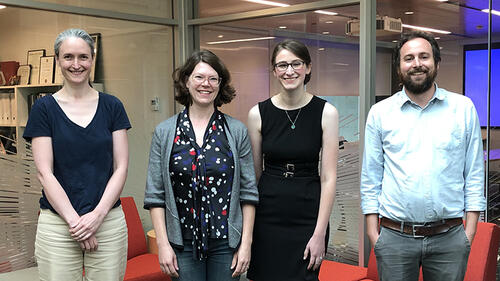
On August 21, 2023, Lauren Saunders successfully defended the thesis “Telescope Pointing for the Simons Observatory: Data Acquisition & Control Software, Calibration, and Modeling” (advisor: Laura Newburgh).
Saunders explained, “By studying the Cosmic Microwave Background (CMB), we can address some of the biggest open questions in physics and cosmology: Did our universe begin with a period of exponential expansion? How have dark matter and dark energy shaped the evolution of our universe? What kinds of light relativistic particles might exist in our universe? To answer these questions with observations of the CMB, we need to build experiments with many more detectors and better control of systematics than has been achieved thus far.”
Saunders continued, “My thesis describes my work developing the platform control and pointing calibration for the Simons Observatory, a new CMB observatory currently being commissioned in the Atacama Desert in Chile. Pointing is one of the limiting systematics for new CMB experiments, and its calibration is critical to our scientific output. To achieve the pointing error limits we need for the Simons Observatory science goals, we need to have well-controlled platform motions as well as highly accurate pointing modeling. My research focused on integrating platform control and data acquisition into the Simons Observatory software system to enable observations, testing the response of the telescope platforms to the software I developed, and developing the models needed to calibrate pointing from astronomical sources.”
Saunders will join Fermilab as a postdoctoral research associate, working on simulations and novel calibration techniques for upcoming CMB experiments.
Abstract: The Simons Observatory (SO) is a ground-based cosmic microwave background (CMB) survey experiment located in the Atacama Desert in Chile, at an elevation of 5200 m. It is made up of one 6m Large Aperture Telescope and three 0.5m Small Aperture Telescopes, and will study the temperature and polarization anisotropies of the CMB. SO will probe the CMB at the smallest angular scales achieved thus far, and with the highest polarization sensitivity, in search of definitive evidence for inflation in the early universe, a glimpse at the dark matter candidates that may have been abundant in the early universe, and improved measurements of LCDM cosmology. Telescope pointing is one of the limiting systematics to the SO scientific outlook, and needs to be well-calibrated and well-understood. I discuss here the instrumentation software efforts to support telescope pointing and scanning, as well as the development of analysis tools for calibrating pointing.
This article was taken from the Wright Lab News article by Victoria Misenti.